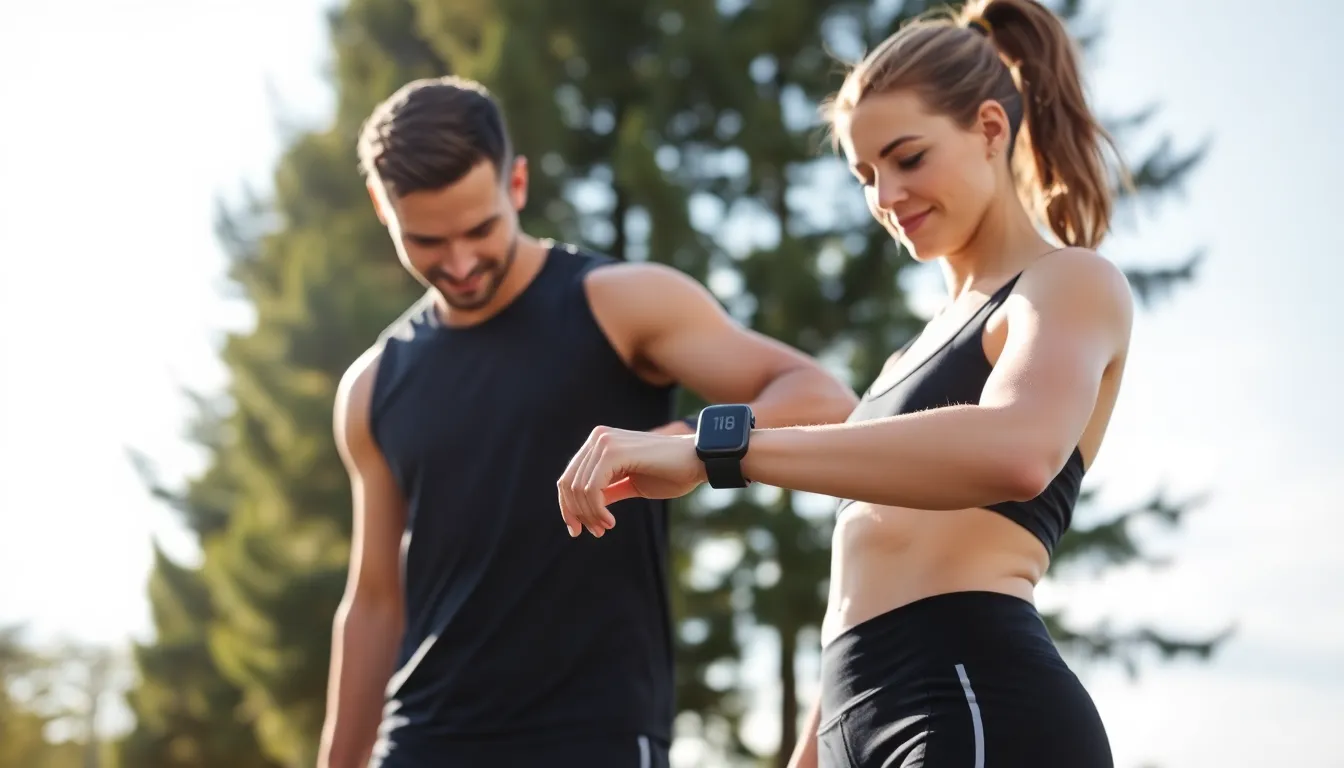In a world where couch potatoes reign supreme, fitness monitoring emerges as the superhero we didn’t know we needed. With wearable tech and apps that track every step, heartbeat, and calorie burned, it’s like having a personal trainer who never judges your late-night pizza escapades. Imagine strapping on a device that not only counts your steps but also gives you a gentle nudge when you’ve been sitting too long.
Table of Contents
ToggleUnderstanding Fitness Monitoring
Fitness monitoring technology has gained significant traction as a crucial element in promoting healthier lifestyles. These tools empower individuals to make informed health decisions and maintain active routines.
Importance of Fitness Monitoring
Fitness monitoring enhances awareness of personal health metrics. Tracking steps taken, heart rate, and calories burned encourages users to meet their fitness goals. Research shows that individuals who regularly monitor their activity levels are more likely to maintain consistent exercise routines. Moreover, these technologies motivate users by providing real-time feedback, reinforcing positive behavior changes. They serve as personal trainers in a pocket, creating accountability and fostering intrinsic motivation. Engaging with fitness tracking can lead to improved overall health and well-being.
Types of Fitness Monitoring Devices
Various devices assist in fitness monitoring, catering to individual needs. Wearable fitness trackers, like smartwatches and wristbands, provide comprehensive health data. These devices often monitor heart rate, step count, and sleep quality. Smartphone apps also offer valuable tracking features, enabling users to set goals and analyze progress. For example, apps may track distance run or calories burned during workouts. Additionally, specialized equipment like smart scales measure weight and body composition metrics. Each of these devices contributes uniquely to a comprehensive understanding of personal fitness.
Key Features of Fitness Monitors

Fitness monitors come equipped with various features designed to enhance health tracking and support active lifestyles. Each feature plays a crucial role in helping users stay informed and motivated.
Heart Rate Tracking
Heart rate tracking stands as a vital feature in fitness monitors. Users can monitor their heart rates during workouts, ensuring they train within optimal intensity zones. Continuous heart rate data helps track cardiovascular health and recovery. Many devices also provide alerts for unusual heart rate fluctuations, promoting safety during physical activities. Studies show that monitoring heart rate correlates with better training outcomes and improved fitness levels.
Activity Tracking
Activity tracking serves as one of the standout functionalities of fitness monitors. These devices count steps taken daily, distance traveled, and calories burned, offering users a comprehensive overview of their activity levels. Specific goals can motivate users to reach daily targets, celebrating achievements with reminders and rewards. Incorporating activity tracking into routines has shown to increase general activity by 30%, making it easier to stay on top of fitness aspirations.
Sleep Monitoring
Sleep monitoring provides valuable insights into sleep quality and patterns. Fitness monitors track the duration and phases of sleep, helping users understand their restfulness. Many devices offer smart alarms that wake users during light sleep, enhancing overall energy levels. With data on sleep trends, individuals can make informed adjustments to improve sleep hygiene. Research indicates that better sleep positively impacts fitness performance and overall health, reinforcing the importance of monitoring this aspect.
Popular Fitness Monitoring Devices
Fitness monitoring devices play a crucial role in encouraging active lifestyles and supporting health. They empower users by tracking their progress and providing valuable insights.
Wearable Technology
Wearable technology includes devices like fitness trackers and smartwatches. These gadgets offer real-time data on steps taken, calories burned, and heart rates. Brands such as Fitbit and Garmin lead the market, providing user-friendly interfaces and long battery life. Users can customize settings to match their fitness goals, ensuring personalized experiences. Many wearables also integrate GPS functionality, allowing accurate tracking of outdoor activities. Moreover, advanced models feature stress management tools and guided breathing exercises, further supporting mental well-being.
Mobile Applications
Mobile applications complement both wearable devices and standalone usage. They offer customizable workout plans and nutritional tracking features. Popular apps like MyFitnessPal and Strava provide comprehensive data analysis and community support. Users can log activities and meals, facilitating better health decisions. Some applications also feature challenges and groups, fostering competitive and supportive environments. User-friendly interfaces simplify navigation, making tracking progress accessible. Integrations with devices enhance monitoring capabilities, ensuring that data syncs seamlessly for a holistic view of fitness.
Benefits of Fitness Monitoring
Fitness monitoring offers numerous advantages that enhance health and well-being. Individuals gain insights into their activity levels, which supports their journey towards improved fitness.
Motivation and Goal Setting
Fitness monitors foster motivation by enabling users to set and track specific goals. Individuals can establish targets for daily steps, exercise duration, or calorie consumption. Achieving these milestones promotes a sense of accomplishment, reinforcing positive habits. Users receive reminders to move, which encourages them to break prolonged periods of inactivity. Engaging in friendly competitions with peers can further boost motivation. Additionally, personalized feedback creates a tailored experience that meets unique fitness aspirations.
Data-Driven Insights
Collecting detailed data enhances understanding of personal health trends. Fitness monitors track vital metrics like heart rate, sleep quality, and activity levels. Users can identify patterns that reveal the effectiveness of workouts and lifestyle choices. Regularly analyzing this information aids individuals in making informed adjustments to their routines. Insights from historical data help refine goal-setting strategies. Real-time feedback encourages users to adapt their activities, ensuring they maximize their workouts for better results.
Challenges and Limitations
Fitness monitoring technology faces several challenges that can impact its effectiveness. Addressing these limitations is essential for users aiming to optimize their health and fitness journeys.
Accuracy and Reliability
Accuracy is a significant concern for fitness monitors. Many devices rely on algorithms that may not provide precise readings, particularly for heart rate and calorie expenditure. Variability in user measurements or skin tones can further affect data reliability. Users might find discrepancies between different devices, leading to confusion about their actual fitness levels. Data accuracy influences goal-setting and motivation, making it crucial for manufacturers to continuously improve their products. Ensuring calibration and validation in real-world scenarios enhances reliability and user trust in fitness technologies.
User Compliance
User compliance is another notable challenge in fitness monitoring. Many individuals struggle to consistently wear devices or engage with monitoring apps. Fatigue or lack of interest can lead to abandonment of fitness tools, hindering potential health benefits. Lack of clear understanding regarding device features can discourage regular use as well. To enhance adherence, fitness monitors should offer user-friendly interfaces and personalized engagement strategies. Creating short-term goals that resonate with users promotes sustained interest. Additionally, fostering community or social aspects can motivate users to remain committed to their fitness journeys.
Fitness monitoring technology has transformed the way individuals approach their health and wellness journeys. By providing real-time feedback and personalized insights, these devices empower users to make informed decisions about their activity levels and overall well-being. The integration of wearable trackers and mobile apps fosters accountability and encourages consistency in fitness routines.
As more people recognize the benefits of tracking their health metrics, the potential for improved lifestyles continues to grow. While challenges remain in terms of accuracy and user compliance, the advancements in fitness monitoring technology promise to enhance the experience and effectiveness of personal health management. Embracing these tools can lead to lasting positive changes and a more active, healthier life.



